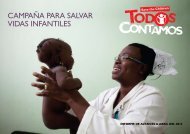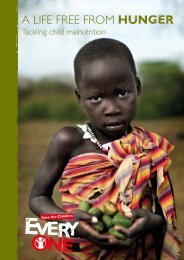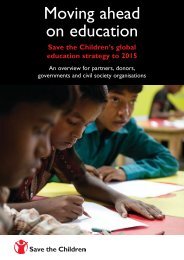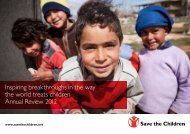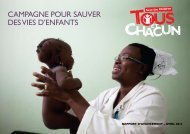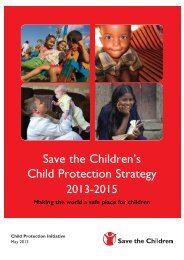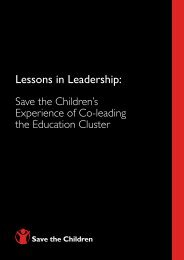NGER A LIFE FREE FROM HUNGER - Save the Children
NGER A LIFE FREE FROM HUNGER - Save the Children
NGER A LIFE FREE FROM HUNGER - Save the Children
Create successful ePaper yourself
Turn your PDF publications into a flip-book with our unique Google optimized e-Paper software.
a life free from hunger<br />
IN BANGLADESH THE PROPORTION OF STUNTED<br />
CHILDREN FELL <strong>FROM</strong> 68% IN 1990 TO 43% IN RECENT<br />
YEARS – A REDUCTION OF 3% PER YEAR, WHICH IS<br />
ONE OF THE FASTEST IN A LOW-INCOME COUNTRY<br />
Bangladesh’s example shows that significant progress is possible even in a low-income<br />
country. <strong>Save</strong> <strong>the</strong> <strong>Children</strong> estimates that if <strong>the</strong> rest of <strong>the</strong> world had been able to match<br />
Bangladesh’s rate of progress on stunting since 1990, <strong>the</strong>re would be 27 million fewer<br />
stunted children in <strong>the</strong> world today. 46<br />
NUTRITION – KEY TO A GROWING ECONOMY:<br />
THE USA’S MILLENNIUM CHALLENGE<br />
CORPORATION AND INDONESIA<br />
The government of Indonesia identified stunting as one of <strong>the</strong> major barriers to<br />
enabling <strong>the</strong> country to grow to have one of <strong>the</strong> strongest national economies<br />
in <strong>the</strong> 21st century. To address this, <strong>the</strong> USA government’s Millennium Challenge<br />
Corporation will provide $131.5 million over five years to reduce stunting in <strong>the</strong><br />
crucial 0–2 age range by investing in <strong>the</strong> 1,000-day window from conception to a<br />
child’s second birthday.<br />
The Millennium Challenge Corporation was created as a model of development<br />
assistance to reduce poverty through economic growth. Using a strict series<br />
of metrics to select recipient countries and measure results – including a hard<br />
threshold for <strong>the</strong> economic rate of return on all projects – <strong>the</strong> Millennium<br />
Challenge Corporation focuses on <strong>the</strong> growth of people and economies.<br />
STUNTING AND EQUITY<br />
Economic growth will not necessarily reduce stunting unless it reaches <strong>the</strong> poorest and<br />
most vulnerable children and <strong>the</strong>ir families. Growth must be equitable so that increased<br />
wealth reaches <strong>the</strong> poorest and most vulnerable and makes an impact on <strong>the</strong> nutritional<br />
intake of those children who need it <strong>the</strong> most.<br />
In <strong>the</strong> 20 countries where around 80% of <strong>the</strong> world’s stunted children live, children from<br />
better-off families face a lower risk of stunting. However, rates of stunting are high across<br />
all wealth groups, from richest to poorest, which suggests that increased wealth is not<br />
enough to prevent stunting.<br />
The trend is slightly different in low-income countries, such as Liberia and Tanzania, from<br />
lower-middle income countries, such as India and Nigeria. Figure 2 opposite divides<br />
<strong>the</strong> population of countries into fifths, according to <strong>the</strong> wealth of <strong>the</strong> household and<br />
compares <strong>the</strong> rate of stunting across <strong>the</strong>se five income groups. Data from 2005 onwards<br />
10



